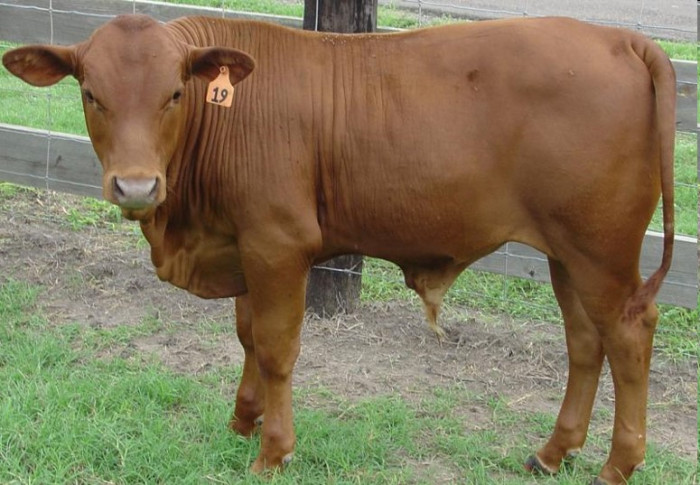Tuli Cattle
The movement South of the Nomadic  migrating African tribes from East Africa brought with them humped cattle. During
many years these cattle became extremely docile with culling of shy and poor breeders
and those cattle that showed poor temperament. This selection over many years has
supplied modern man with a basis of good genetic material with which to breed for
present day requirements.
migrating African tribes from East Africa brought with them humped cattle. During
many years these cattle became extremely docile with culling of shy and poor breeders
and those cattle that showed poor temperament. This selection over many years has
supplied modern man with a basis of good genetic material with which to breed for
present day requirements.
In 1942, while working in the lowveld regions of Southern Zimbabwe, Mr Len Harvey noticed that there appeared to be a distinct type of yellow Sanga cattle amongst the ordinary mixed native stock. These cattle seemed better adapted to the harsh local conditions and were superior to other stock. As a result of these observations, the government decided to purchase some of these cattle to see if they could be improved and whether they could breed true to type.
During 1945, 3,000 acres were set aside in the same area for the establishment of a cattle breeding station. With the fencing complete in the 1946-47 rainy season a herd consisting of 20 cows and a bull were purchased from local people. Between 1947 and 1950 the station was run by Mr. Harvey in addition to his other duties. In 1950, however, it was decided that the station was to serve the whole lowveld and Mr. Harvey was appointed as full time officer in charge. The station was extended to 20,000 acres and as development and fencing increased, the herd was also increased.
The basic idea of the then named, Tuli Breeding Station, was to assist in improving stock in the outlying areas of Zimbabwe. The commercial cattle farmers soon realized the potential of the breed and for many years breeding stock was sold to them. The formation of the Tuli Breed Society took place in 1961. The Constitution and Regulations of the Society have received praise from many authorities.
The herd was moved to the Matopos Research Station in 1979 and as expected, adapted well to its new environment. The breed was soon to be found thriving throughout Zimbabwe and now in South Africa.
The potential of the Tuli was soon recognized by South African cattle breeders and numerous imports have resulted in the establishment of an active, ever increasing breeding population in South Africa.
High fertility, hardiness, adaptability and excellent beef qualities, coupled with a docile nature have made the Tuli extremely popular in straight and cross-breeding programs. The most recent development that has led to increased international interest in the Tuli breed is the discovery, through research at Clay Centre in Nebraska, USA that the Tuli produces meat of exceptionally high quality. In a trial of several breeds the Tuli had the most juicy meat and was second to the Angus for marbling.
The Tuli are naturally polled cattle that have three basic coat colours i.e. red, yellow and white and variations of these colors occur.
Use this breed in straight or cross-breeding programs for its unique combination of attributes, e.g. hardiness, fertility, adaptability, ease of calving, good mothering ability and excellent carcass quality.
References
Information provided by Select Genes Ltd., PO Box 494, Irene 1675, Republic of South Africa.
Phone: 27-12-6671129
Fax: 27-12-6671827
